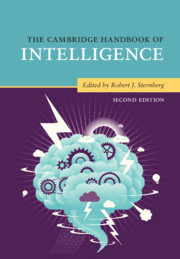Book contents
- The Cambridge Handbook of Intelligence
- The Cambridge Handbook of Intelligence
- Copyright page
- Dedication
- Contents
- Figures
- Tables
- Contributors
- Preface
- Part I Intelligence and Its Measurement
- Part II Development of Intelligence
- Part III Intelligence and Group Differences
- Part IV Biology of Intelligence
- Part V Intelligence and Information Processing
- Part VI Kinds of Intelligence
- Part VII Intelligence and Its Role in Society
- Part VIII Intelligence and Allied Constructs
- 42 Intelligence and Personality
- 43 Intelligence and Achievement
- 44 Intelligence and Motivation
- 45 Intelligence and Creativity
- 46 Intelligence and Rationality
- 47 Intelligence and Wisdom
- 48 Intelligence and Expertise
- Part IX Folk Conceptions of Intelligence
- Part X Conclusion
- Author Index
- Subject Index
- References
44 - Intelligence and Motivation
from Part VIII - Intelligence and Allied Constructs
Published online by Cambridge University Press: 13 December 2019
- The Cambridge Handbook of Intelligence
- The Cambridge Handbook of Intelligence
- Copyright page
- Dedication
- Contents
- Figures
- Tables
- Contributors
- Preface
- Part I Intelligence and Its Measurement
- Part II Development of Intelligence
- Part III Intelligence and Group Differences
- Part IV Biology of Intelligence
- Part V Intelligence and Information Processing
- Part VI Kinds of Intelligence
- Part VII Intelligence and Its Role in Society
- Part VIII Intelligence and Allied Constructs
- 42 Intelligence and Personality
- 43 Intelligence and Achievement
- 44 Intelligence and Motivation
- 45 Intelligence and Creativity
- 46 Intelligence and Rationality
- 47 Intelligence and Wisdom
- 48 Intelligence and Expertise
- Part IX Folk Conceptions of Intelligence
- Part X Conclusion
- Author Index
- Subject Index
- References
Summary
In this chapter, we argue that to understand intelligence one must understand motivation. In the past, intelligence was often cast as an entity unto itself, relatively unaffected by motivation. In our chapter, we spell out how motivational factors determine (1) whether individuals initiate goals relating to the acquisition and display of intellectual skills, (2) how persistently they pursue those goals, and (3) how effectively they pursue those goals, that is, how effectively they learn and perform in the intellectual arena. As will be seen, motivational factors can have systematic and meaningful effects on intellectual ability, performance, and accomplishment over time. Our discussion emphasizes that heritability is not incompatible with the malleability of intelligence and that motivation is the vehicle through which intellectual skills are successfully acquired, expressed, and built upon.
Keywords
- Type
- Chapter
- Information
- The Cambridge Handbook of Intelligence , pp. 1061 - 1086Publisher: Cambridge University PressPrint publication year: 2020

